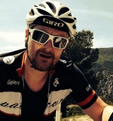"In Rookhope I was first aware
Of Self and Not-Self, Death and Dread.
There I dropped pebbles, listened, heard
The reservoir of darkness stirred"
That "splendid old bugger" WH Auden wrote this verse in New Year Letter', 1940, recalling memories of childhood holidays spent in the Pennines. While exploring the North Pennines a young Auden discovered Sike Head Shaft on the slopes of Bolt's Law Moor, an abandoned pit site with rusting mine works and two ramshackle tall chimneys overlooking Rookhope. Auden described having a vision of his future on the moor and cites this as the major turning point in his life from budding poet to creative being.
As I dodged the deluge of rain and leapt over the tremendous puddles to sign on for the Etape Pennines in the grounds of the Bowes Museum, Barnard Castle I also had a vision of my future... It was going to be hilly and wet and then hilly again.
The Marie Cure Cancer Care Etape Pennines is now in its third year and continues to go from strength to strength. With entrants numbering in their thousands it seems there is no shortage of individuals keen to take on what is regarded alongside the Fred Whitton as one of the UK's toughest sportives.
As a local lad, living in Darlington and schooled in Barnard Castle, the opportunity to ride on closed home roads for such a long distance was too tempting and I had been looking forward to participating since I returned from the Granfondo Ventoux. I had also been harbouring a smug disdain for the hills we have in the UK, which are not even remotely as harrowing as the mountains of France. Pairing this with the fact that I regularly train in the local area, my confidence was at a particularly high level ahead of the Etape and I scoffed at reviews I read describing it as 'brutal', 'severe' and 'gruelling'. Pah, silly little Engleesh race!
The 2014 Etape Pennines took place on Sunday 20th July, and any meteorologists among you may remember that weekend as one when we received some particularly intense thunderstorms from our Gaelic neighbours across the water. As I have briefly mentioned, 'sign on' on the Saturday before the event was a particularly hurried and wet affair with torrential rain coupled with fog and humid conditions, the perfect mix for a bike race. If the entrants' overriding preoccupation hadn't been to keep themselves and their race pack dry they could have appreciated the grandeur and beauty of the Bowes Museum and its gardens. Amongst its many secrets are a silver swan that comes alive to eat silver fish, and a two-headed calf that was paraded around the region in the early 1800s as part of a freak show. This is what I can remember from a school trip from some 25 years ago; I was too busy this time keeping my head out of the rain to look around!
My alarm went off at 5:30am the following morning...I turned it off. At 5:50am I woke with a start and looked at the ceiling, was it Monday? No. Why on earth did my alarm go off? Was it actually my wife's alarm? No. I pondered for a moment as I slowly came round like a boxer after an uppercut. The Etape! Starts at 6:30am! Insert expletive here! Within 5 minutes I was on the road, half dressed, espresso spilling on my lap, peeling a banana and changing gear in my car. At least the roads would be quiet. No dramas, Barnard Castle is only a 20 minute drive which would leave me 10 minutes to park, get kit on, sort out bike, warm up and get to the start line. Easy.
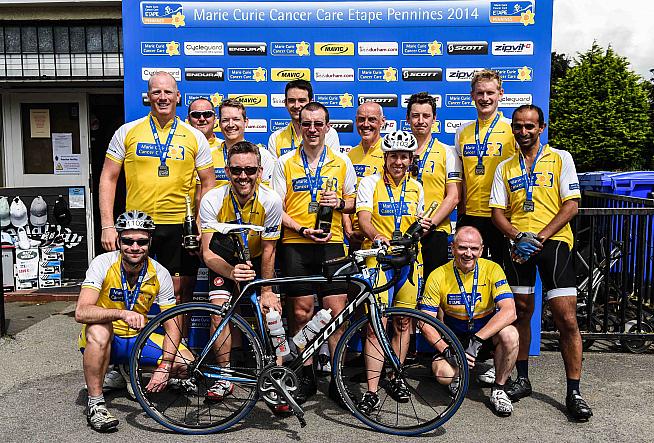
Approaching the roundabout that would take me from Darlington and out to Barnard Castle a sign began to loom into vision, a reasonably big yellow sign, a sign that stated 'ROAD CLOSED - FOLLOW DIVERSION'. No! I pressed on, taking an indirect route out of Darlington into the dank misty countryside. It was ok, I would have 5 minutes to park, get kit on, sort bike, warm up and get to the start line. At that point I figured I would forget the warm-up and park as close as I could possibly get to the start. Don't panic Mr Mainwaring.
On arriving in Barnard Castle it was obvious that the organisation of the Etape was taken seriously. There were armies of fluoro-wearing individuals along every street, monitoring side roads and managing cars. They were a very helpful, friendly and efficient lot and I was parked in Glaxo car park, a mere stone's throw from the start line, in minutes. In an astonishing whir of kit/bike/hydration multi-tasking, I was ready with not a minute to spare and I rolled out to the start line. Again the co-ordination of all the staff of the Etape was evident as we filed easily and hassle-free to the start, all the time being clapped and encouraged and entertained by the PA. At 6:30am we set off. The skies were grey and it was humid, but it was dry and there was no obvious threat of rain. Result.
We set off to our first destination, Middleton-in-Teesdale. We rode uphill steadily climbing to Folly Top. The mood was jovial except for a few rather serious riders that shot off and were obviously up for a good time. From Folly Top we rolled on to Eggleston and along to Toby Hill and up the Stotley Grange Climb. The views either side of us were outstanding: Mickleton and Romaldkirk in the distance, enveloped in the hills and valleys of England's green and pleasant land. In the early morning light the excitement and the prospect of the day's endeavour was easy to see on the faces of my fellow riders and these early clicks did nothing to dampen the mood.
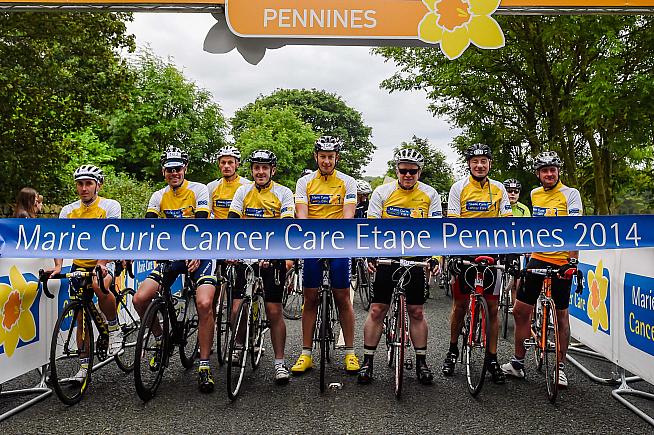
We dropped down into Middleton-in-Teesdale and along the draggy false flat which takes you up to High Force. High Force in full flood is a dramatic and fantastic sight with its 71 foot vertical drop falls; however, today the only dramatic sights to behold were dressed in ill-fitting lycra and riding overpriced carbon fibre steeds. The first feed station was situated in the car park of the High Force Hotel and was a banquet of ZipVit gels, flapjacks and bananas. I grabbed three gels in flavours cherry bakewell, kiwi, and rhubarb and custard - the food of champions. With this first feed station being only 15 miles into the ride many competitors decided not to stop and to push on, but I have learnt from past experience on many rides: eat often and lots while you can.
As the miles passed I was more and more aware of the fact that there had not been any flat sections, and as we continued a sign indicating the KOM segment further proved that there would not be any flat sections making an appearance any time soon. The Etape, like many newer sportives has included aspects of conventional road racing to spice things up a bit and change the tempo. KOM and sprint sections always help to break up the monotony of a long ride and make things interesting. The powers that be had decided to situate the KOM just after Langdon Beck on the climb out to Langdon Common and onto Ireshope Moor. For a mountain goat like me, 14.5st, 6ft 2in, riding a 52/39 chainring, well it was nailed on. I decided with a selfless gesture of philanthropic benevolence not to compete in the KOM and to enjoy the climb... I'm all heart me!
Now according to Newton's Law of Universal Gravitation, what goes up must come down. (Well that's not entirely scientifically accurate, it has more to do with the attraction force between two objects and the proportional mass and distance - at least that's what Wikipedia says, I spent most of physics class looking out the window or stood in the corner.) The down part on the other side of the KOM climb was the Harthorpe descent towards St John's Chapel and over the Burnhope reservoir. This was a serious descent, steep and straight with a cattle grid halfway down for good measure. Speeds were soon up into the high 40mph and with the use of the whole road it enabled riders to really let go. I eased down into an aero tuck and looked ahead, spotting my lines. I glanced down at my Garmin as the cattle grid approached: I had hit 52mph. Woah woah woah! In a split second I envisioned what would happen if I hit the metal and came off at this speed, it wasn't a great picture. I eased on the brakes and regained control at a steady 45mph and readied for the cattle grid. Straight over no dramas. Something else had happened as we had left Teesdale and entered Weardale: the clouds had broken and the sun and blue sky were out in force. This was drying up the road well and made for even more safe descending.
Weaving round the rolling course was now a joy and everyone was into their riding. People were happy to chat when passing with sarcastic words of encouragement as only the British do so well. In the back of my mind I knew what was coming so I took in a gel and some liquid in preparation for the Mur de St John's Chapel. It was upon us before we knew it. A sharp left hand turn from a steady downhill catapulted us onto Well Bank and the start of St John's Chapel.
A cacophony of rapid clicking and disapproving vocabulary filled the air. I clicked down into my lowest gear, 39/28. Again I had failed to even think about fitting a compact chainset and was beginning to really regret it. Some riders span past me with what looked like smaller chainring on the front than the back, perhaps a 30/32! Anyway, I sat and ground and zig-zagged up. As I mentioned the sun was out and drying up the roads nicely, but unfortunately because of the overhanging trees and shaded areas this road remained greasy and wet; add to that a large patch of spilt diesel and the results were skidding back wheels and zero traction. I dabbed.
For those of you unaware of the verb and definition of a 'dab', please allow me to enlighten you. The urban dictionary defines it as follows:
dab
'to touch one's foot to the ground while cycling. Considered to be a lost style point among all cyclists.'
"Mate you totally dabbed on that last climb, you are such a soft lad!" (This may have actually been said to me several years ago while riding over Buttertubs Pass.)
So in essence 'dabbing' shows weakness, reduces style and ultimately stops you from riding your bike and results in pushing your steed in the walk of shame. As an aspiring Euro Cyclist, none of this is what I needed! The Mur de SJC seemed to go on forever, although in reality it was probably only 1.5 miles. I'd managed to get back on after my initial humiliation and completed the climb with mouth and jersey wide open. After SJC came the rapid Middlehope Mine descent and this is where I hit my top speed for the day, a buttock-clenching 55mph. Add in to that a speed wobble, a crashed rider to my right and a sketchy wet/dry left then right hand corner and what you get is a white knuckle ride that was about as much fun as squeezing lemon juice in your eyes.
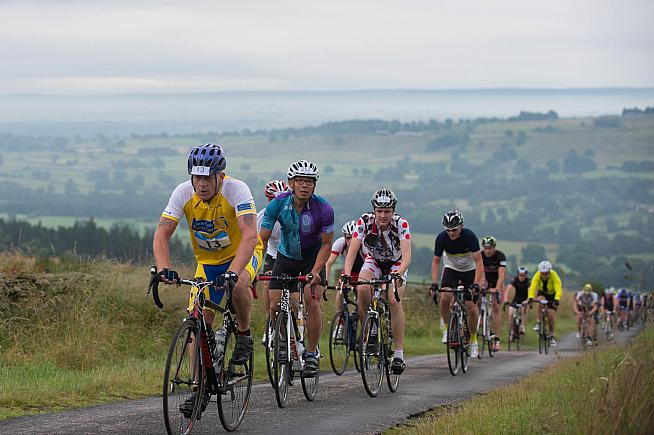
Arriving at the next feed station we were over halfway into the ride and feeling good. Spirits continued to be high as riders joked and swapped stories of near offs and breakneck riding. We were also into Rookhope and about to start the long steady haul up to Bolt's Law Moor and ultimately Blanchland. The roads continued their relentless up and down curvature giving riders only brief respite. The views are often described as desolate and bleak in this part of the world, and in the grey light it can be understood. However, today the sun was shining down and was helping to pick out the variety of colours amongst the heather, mosses and soft rush. The deserted farm buildings and mine works, far from looking dilapidated, stood strong and proud as a reminder of stories and history passed. WH Auden would be proud.
Blanchland is reported to be one of the most haunted villages in Northumberland, if not the UK. Whether it is monks, Jacobite rebels or French bombardiers, all are said to walk amongst the houses at night. The climb of Bale Hill out of Blanchland takes you up onto the top and Meadows Edge. Along the top with a favourable cross-tailwind, was situated the sprint segment. As I had made friends with a Scottish fellow and we were having such an in depth conversation about bikes, riding and the Tour de France we decided to just roll through, and if the truth be known I was very grateful of his company to take my mind off my aching muscles.
Crawleyside was yet again another entertaining up and down combination and brought us into the sun-drenched village of Stanhope. We were nearly there. One more moor to go - Bollihope Common. The start of the climb up and over the Bollihope is the novelly named Unthank Bank. Like something out of The Hobbit, it should be a small grass covered hill allowing people to roll down in fits of laughter - not a wall with switchbacks and leg-sapping elevations. I passed one rider who had succumbed to bilateral leg cramp and was sitting legs straight on the road, bike banished into the gutter, a strange smile across his face.
After the climbing we had completed the ride to the top of the Bollihope was a much more steady affair, and it was easy to get into a good rhythm. Once over the top the worst was over. A swift, snaking downhill into Eggleston left only one more steep ascent, Windy Hill, which brought us back up to Folly Top and a re-trace of our initial few miles, only this time it was a mad dash, aerotuck hurtle to the finish.
I would like to thank everyone involved with the Marie Curie Cancer Care Etape Pennines. It is without doubt the best organised sportive I have competed in, and with the closed roads and kind weather it was a pleasure to ride. Special thanks to Jo O'Connell and Yvette Thompson for all their help. The Etape Pennines deserves its place on everyone's list of must-do UK sportives. I am looking forward to completing it again next year along with the Etape Caledonia - the two sportives that comprise the Etape series - and can not recommend this event highly enough to anyone thinking of taking on the Pennines challenge.
If you like vertiginous hills, striking scenery and daredevil downhills this is the event for you. I look forward to seeing you in 2015.
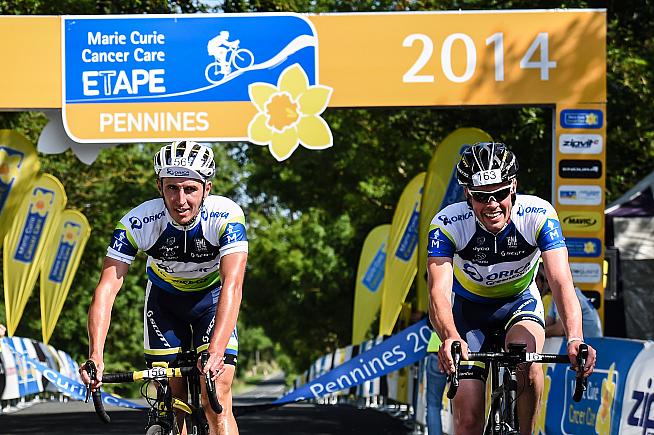
0 Comments

